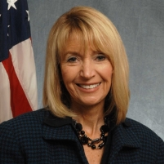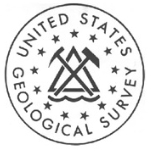Located within the Department of the Interior, the United States Geological Survey (USGS) is an independent fact-finding agency that collects, monitors, analyzes, and provides scientific understanding about natural resource conditions, issues, and problems. Originally founded in an effort to map and survey the U.S. territories, today’s USGS program areas include biology, geography, geology, geospace and water. As a federal agency with a mandate for objective scientific study, the USGS often finds itself in the crossfire of political debates over global warming, nuclear waste and nature/wildlife conservation.
USGS and Fish & Wildlife Service: Future Challenges
Caribou study charges energy debate
(by Lisa M. Pinsker, Geo Times)
Resources for oil peak debate at Hubbert Peak
- Table of Contents
- Overview
- History
- What it Does
- Where Does the Money Go
- Controversies
- Suggested Reforms
- Comments
- Leave a comment

Suzette Kimball, who has been acting director of the U.S. Geological Survey (USGS) since February 2013, was nominated by President Barack Obama on January 9, 2014, to fill the job permanently. The USGS director is responsible for providing scientific information to understand the Earth, minimizing loss of life and property from natural disasters and managing water, biological, energy, and mineral resources.
Kimball graduated from the College of William and Mary in 1973 with a degree in English while also completing the requirements for a geology degree. She went on to earn a master’s in geology and geophysics from Ball State University in 1981 and a Ph.D. in environmental sciences from the University of Virginia in 1983. During this period, she was also a research coordinator and a research assistant at the Department of Environmental Sciences at the University of Virginia.
From 1983 to 1986 Kimball worked for the U.S. Army Corps of Engineers as a coastal engineering research center chief and a program manager for barrier islands sedimentation studies. Subsequently, she served as co-founder and co-director of the center for coastal management and policy and as associate marine scientist at the Virginia Institute of Marine Science at the College of William and Mary.
Kimball joined the National Park Service (NPS) in 1991, again focusing on barrier islands. She was a research coordinator in the NPS global climate change program until 1993, when she was named southeast associate regional director of natural resource stewardship and science, holding this position until 1998, when she joined USGS.
Kimball’s first job there was as eastern regional executive for biology. She moved up the ranks, becoming director of the USGS Eastern Region in 2004 and being named associate director for Geology in 2008.
In 2010, Kimball was named deputy director of the USGS. In that post, she led USGS's international activities and represented all North American geological surveys on international mapping endeavors.
In summer 2012, Kimball was also named Interior's top official for scientific integrity.
She has written more than 75 publications on coastal ecosystem science and coastal zone policy.
Kimball is married to Curt Mason, a retired coastal oceanographer. Ironically, they live nowhere near the ocean. Instead, their home is one of the oldest houses in West Virginia, having been built about 1740. Kimball has three children and six grandchildren.
-Steve Straehley
To Learn More:
Secretary Jewell Lauds President’s Intent to Nominate Suzette Kimball to Serve as Director of the U.S. Geological Survey (U.S. Department of the Interior)

Marcia K. McNutt, President Barack Obama’s choice to lead the U.S. Geological Survey (USGS), was confirmed by the U.S. Senate October 21, 2009. McNutt is a geological scientist whose oceanography work includes training with Navy SEALS in underwater explosives, going on fifteen ocean study voyages, researching volcanoes and studying the forces behind the uplift of the Himalayan mountains.
Marcia McNutt Interview (National Academy of Sciences)
- Latest News
- D.C. Public Schools will Teach all Second-Graders to Ride a Bike
- New Rule in Germany Limits Sales of Sex-Themed E-Books to 10pm to 6am
- What Happened to the 6-Year-Old Tibetan Boy the Chinese Government Kidnapped 20 Years Ago?
- U.S. Ambassador to Turkey Photoshops his Hair Color to Mock Turkish Mayor
- Mystery Artist Calls Attention to Unfixed Potholes by Drawing Penises around Them
Located within the Department of the Interior, the United States Geological Survey (USGS) is an independent fact-finding agency that collects, monitors, analyzes, and provides scientific understanding about natural resource conditions, issues, and problems. Originally founded in an effort to map and survey the U.S. territories, today’s USGS program areas include biology, geography, geology, geospace and water. As a federal agency with a mandate for objective scientific study, the USGS often finds itself in the crossfire of political debates over global warming, nuclear waste and nature/wildlife conservation.
USGS and Fish & Wildlife Service: Future Challenges
Caribou study charges energy debate
(by Lisa M. Pinsker, Geo Times)
Resources for oil peak debate at Hubbert Peak
Comments

Suzette Kimball, who has been acting director of the U.S. Geological Survey (USGS) since February 2013, was nominated by President Barack Obama on January 9, 2014, to fill the job permanently. The USGS director is responsible for providing scientific information to understand the Earth, minimizing loss of life and property from natural disasters and managing water, biological, energy, and mineral resources.
Kimball graduated from the College of William and Mary in 1973 with a degree in English while also completing the requirements for a geology degree. She went on to earn a master’s in geology and geophysics from Ball State University in 1981 and a Ph.D. in environmental sciences from the University of Virginia in 1983. During this period, she was also a research coordinator and a research assistant at the Department of Environmental Sciences at the University of Virginia.
From 1983 to 1986 Kimball worked for the U.S. Army Corps of Engineers as a coastal engineering research center chief and a program manager for barrier islands sedimentation studies. Subsequently, she served as co-founder and co-director of the center for coastal management and policy and as associate marine scientist at the Virginia Institute of Marine Science at the College of William and Mary.
Kimball joined the National Park Service (NPS) in 1991, again focusing on barrier islands. She was a research coordinator in the NPS global climate change program until 1993, when she was named southeast associate regional director of natural resource stewardship and science, holding this position until 1998, when she joined USGS.
Kimball’s first job there was as eastern regional executive for biology. She moved up the ranks, becoming director of the USGS Eastern Region in 2004 and being named associate director for Geology in 2008.
In 2010, Kimball was named deputy director of the USGS. In that post, she led USGS's international activities and represented all North American geological surveys on international mapping endeavors.
In summer 2012, Kimball was also named Interior's top official for scientific integrity.
She has written more than 75 publications on coastal ecosystem science and coastal zone policy.
Kimball is married to Curt Mason, a retired coastal oceanographer. Ironically, they live nowhere near the ocean. Instead, their home is one of the oldest houses in West Virginia, having been built about 1740. Kimball has three children and six grandchildren.
-Steve Straehley
To Learn More:
Secretary Jewell Lauds President’s Intent to Nominate Suzette Kimball to Serve as Director of the U.S. Geological Survey (U.S. Department of the Interior)

Marcia K. McNutt, President Barack Obama’s choice to lead the U.S. Geological Survey (USGS), was confirmed by the U.S. Senate October 21, 2009. McNutt is a geological scientist whose oceanography work includes training with Navy SEALS in underwater explosives, going on fifteen ocean study voyages, researching volcanoes and studying the forces behind the uplift of the Himalayan mountains.
Marcia McNutt Interview (National Academy of Sciences)
- Latest News
- D.C. Public Schools will Teach all Second-Graders to Ride a Bike
- New Rule in Germany Limits Sales of Sex-Themed E-Books to 10pm to 6am
- What Happened to the 6-Year-Old Tibetan Boy the Chinese Government Kidnapped 20 Years Ago?
- U.S. Ambassador to Turkey Photoshops his Hair Color to Mock Turkish Mayor
- Mystery Artist Calls Attention to Unfixed Potholes by Drawing Penises around Them






Comments